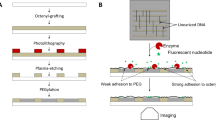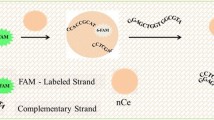Abstract
A new methodology for the analysis of DNA polymorphisms has been developed using specific oligonucleotide strand arrays bound to a solid silicon support recovered by a thin layer of silica. Arrays of directly synthesized oligonucleotides covalently fixed on Si/SiO2 wafers have been designed at the macroscopic scale. Using suitable nucleotide-labeled units, the fluorescence emission technique has been used as an experimental control of the molecular network bound to the support and as a method for analyzing the hybridizing abilities of the corresponding oligonucleotide array. Fluorescein has allowed us to control the molecular density of the DNA strand resulting from a complete synthetic growing process. A specific protocol using both complementary and noncomplementary units labeled with two probes, Cy3 and Cy5, was used to distinguish clearly nucleotide units fixed on the array either as hybridized sequences or by the unavoidable adsorption process. The present performance of this fluorescence detection procedure will now be used with a scanning fluorescence device to perform the analysis at the microscopic scale.
Similar content being viewed by others
REFERENCES
K. Wachsmuth (1985) Infect. Control 6, 100.
T. Caskey (1987) Science 236, 1223.
J. Hillel, T. Schaap, A. Haberfeld, A. J. Jeffreys, Y. Plotsky, A. Cahaner, and U. Lavi (1990). Genetics 124, 783.
G. Sutherland and J. Mulley (1989) in R. H. Symons (Ed.), Nucleic Acid Probes, CRC Press, Boca Raton, FL, pp. 159-201.
L. J. Kricka (1992) Nonisotopic DNA Probe Techniques, Academic Press, Toronto, pp. 3-19.
G. H. Keller and M. M. Manak (1989) DNA Probes, Macmillan (Stockton Press), New York, pp. 149-213.
J. Dicesare, B. Grossman, E. Katz, E. Picozza, R. Ragusa, and T. Woudenberg (1993) Biotechniques 15, 152.
M. Schena (1996) Bioassays 18, 427-431.
B. R. J. Jordan (1998) Biochemistry 124, 251-258.
A. C. Pease, D. Solas, E. J. Sullivan, M. T. Cronin, C. P. Holmes, C. P. Fodor (1994) Proc. Natl. Acad. Sci. USA 91, 5022-5026.
J. Cheng, E. L. Sheldon, L. Wu, M. J. Heller, and J. P. O'Connell (1998) Anal. Chem. 70, 2321-2326.
P. N. Gilles, J. D. Wu, C. B. Foster, P. J. Dillon, and S. J. Chanock. (1999) Nature Biotechnol. 17, 365-370.
U. Maskos and E. M. Southern (1992) Nucleic Acids Res. 20, 1679-1684.
E. Souteyrand, J.-P. Cloarec, J.-R. Martin, C. Wilson, I. Laurence, S. Mikkelsen, and M.-F. Laurence (1997) J. Phys. Chem. B 101, 2980-2985.
M. Southern (1992) Nucleic Acids Res. 20, 1679-1684.
Author information
Authors and Affiliations
Rights and permissions
About this article
Cite this article
Bras, M., Cloarec, JP., Bessueille, F. et al. Control of Immobilization and Hybridization on DNA Chips by Fluorescence Spectroscopy. Journal of Fluorescence 10, 247 (2000). https://doi.org/10.1023/A:1009472304903
Issue Date:
DOI: https://doi.org/10.1023/A:1009472304903




